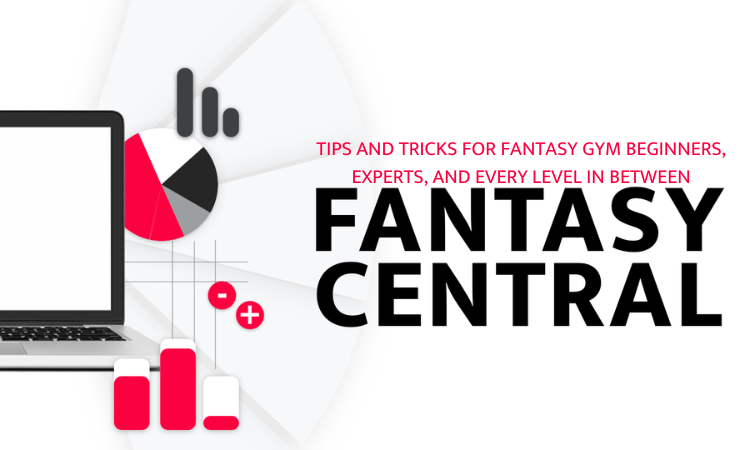Whether you’re a first-year player or have been a fantasy gym nerd from the beginning, everyone needs a refresher now and then. Here are our top tips for everything from drafting to maximizing your scoring potential week to week.
Getting Started
If you’re brand new, here’s your overview:
Gymlytics is your home for everything fantasy (don’t worry if the page doesn’t look like much when you visit; the site may be preparing for season). Users can create an account and manage up to five public teams. Users can also participate in private leagues with friends, hosted by a commissioner.
Drafting can be done one of two ways: You can simply input your draft order on the site and you’ll receive your team via snake draft in your league, or if you’re in a league with friends, you can host a live draft and everyone can input their teams on the site. For the latter, have everyone simply add their drafted gymnasts to their own draft on the site, which will then assign those gymnasts to their teams when the computerized draft runs.
Teams have 20 members, and the default settings are for 10 gymnasts to go up in each lineup with five scores counting, meaning each lineup drops the lowest five scores. Commissioners can change these settings in private leagues.
Each week, then, your final score is your top five numbers on all four events, just like in NCAA gymnastics. A player wins their league by having the highest average score at the end of the season. Note that Gymlytics doesn’t have a postseason challenge since leagues vary in size. A player can also check their standings against every public Gymlytics team.
Just like in other fantasy sports, players can participate in a waiver wire to trade gymnasts. This usually opens after the third or fourth week of the season. We have tips below.
If it all seems complicated, don’t worry! The site is very user friendly, and you can check back here each week where our Fantasy Central series will help guide you through.
Drafting
Don’t miss our drafting tool, which allows players to set parameters to create a customized draft list. We also have sample themed drafts available.
The draft is perhaps the single most important part of fantasy gymnastics, other than remembering to set your lineups week to week. Every player has a different strategy, but it’s generally agreed that having at least one top all-arounder is important, as well as several very strong two- and three-event gymnasts. If you start this way, it’s easy to fill out your draft with strong event specialists and all-arounders with a standout event or two.
If you are using the snake draft on Gymlytics, don’t forget to stack as many top gymnasts on the top of your list as you can. League sizes depend on how many players choose to participate each year, so we can’t say for certain what your lowest potential first-round pick will be. That said, it’s entirely possible that the 20th gymnast on your draft might be your top pick!
It’s key to fill out your whole draft list, all the way to No. 200. If you don’t, you run the risk of being randomly assigned gymnasts and might end up with someone injured or who doesn’t compete.
Advice from USAG expert Rebecca is to, generally speaking, hold off on drafting gymnasts on those teams (roughly Division II and Ivies). In her experience, standout gymnasts in the USAG division take a few weeks to really put up the big numbers, making them great waiver wire trades.
And of course, be sure to double check our injury updates before finalizing your draft! We suggest avoiding anyone out with a major or season-ending injury, and be cautious about anyone else, putting them lower on your draft if you feel like you can’t leave them off entirely.
Waiver Wire
Whatever you do, don’t submit only one waiver wire trade if you really want to drop someone!
The waiver wire operates on a snake priority system, just like the initial draft. You might not be first in line, and if Jane Doe had a really good breakout performance, you’ll likely have competition to pick her up. If you try to drop Amy Beth, who got injured, to pick up Jane Doe, and a player ahead of you picks up Jane Doe, you’ll have Amy Beth on your team for another week if you don’t have backup options in the waiver wire.
Below is a sample waiver wire when you want to drop Amy Beth, where Jane Doe is your prioritized pickup, and you’re also interested in Sarah Elizabeth but are in no rush to drop Terry Beth.
Pick up: Jane Doe, drop: Amy Beth
Pick up: Rory Lane, drop: Amy Beth
Pick up: Patty Rae, drop: Amy Beth
Pick up: Sarah Elizabeth, drop: Terry Beth
This way, even if Jane Doe is taken, you might get Rory Lane or Patty Rae for Amy Beth.
We also strongly recommend that you avoid going waiver wire bananas. It’s easy to over-trade! We’ve all dropped a gymnast after one off week just to see her score a 9.900 on someone else’s team the next.
Lineups
There are two golden rules for setting lineups each week: Double check which teams are on byes, and double check that none of your gymnasts are injured.
Luckily for players, Gymlytics uses CGN’s injury list and master schedule to list major injuries and byes right on your lineup page each week. Plus, we’ll call out both injuries, byes, and double meet weekends in our weekly Fantasy Central article.
Keep an eye out, too, for really high scoring meets (usually big invitationals or rivalry meets) or potential rest meets. Sometimes when high-ranked teams visit lower-ranked opponents toward the end of the season, they rest their superstars, especially all-arounders, and you don’t want to accidentally have to factor in a zero.
The 10 up five count nature of Gymlytics does allow for a little more lineup risk than previous iterations of the game. The key thing to remember is that a lot of risky gymnasts in one lineup is when things get shaky; you want some reliably high scores in each lineup each week.
READ THIS NEXT: Fantasy Central: Sample Drafts for Your 2024 Team
Article by Emily Minehart





2 comments